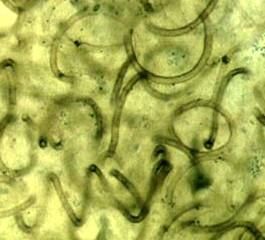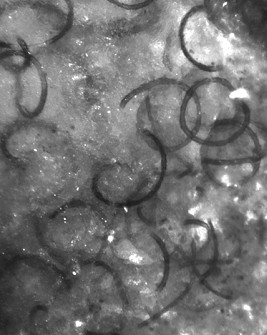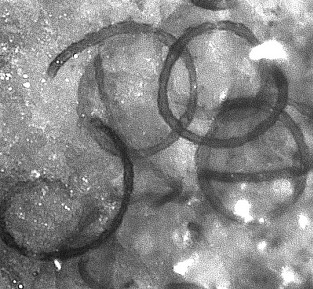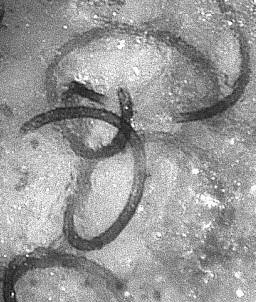There are a few more plants consisting of a felt of tubes, but none of them has got its tubes wound into a thread. They are called nematophytes, which means filamentous plants. They clearly differ from the various extant types of filamentous algae. What they may have in common is some kind of gel binding the tubes into a larger entity and keeping out floating debris and aquatic creatures.
|
|
|
|
Nematoplexus rhyniensis was described by A.G. Lyon on the basis of only one chert sample of a rare variety without the usually abundant remains of terrestrial plants. The sample presented here is of the same type, and it is distinguished by the presence of the aquatic crustacean Castracollis, which has been repeatedly found recently in samples of the common chert type with flooded terrestrial plants.
The present specimen of Nematoplexus (Figs.2-4) has been discovered
by inspecting the smooth surface of a chert layer fragment of 0.28kg. The
typical coil fragments are seen scattered over a patch of about 5 mm across.
Judging from the much larger specimen in Fig. 1 from Lyon (1961-62), this
patch is not representative of the whole. So it does not show structures
other than the smooth coiled tubes, in a more or less broken state.
As seen in Figs. 2-4, this specimen, too, shows the feature of right-handed
thread. By taking into account the foreshortening of the coils in these pictures,
it appears that the feature of pitch equalling thread diameter is also realized
here.
What distinguishes the present specimen from the type specimen of
Nematoplexus rhyniensis is the conspicuously larger structure
size.
|
tube diameter [µm] |
thread diameter [µm] |
type specimen (Lyon 1961-62) |
(7)-8-9-(10) |
80-120 |
this sample |
10-14 |
130-180 |
With the presently sparse fossil evidence of Nematoplexus, which is apparently restricted to the type specimen and the sample described here, it seems not justified to regard the bigger variety as a new species. This may be reconsidered as soon as more finds revealing other details become available.
H.-J. WEISS 2009
Figs. 2-4: photographs by C. KAMENZ
References
A.G. LYON: On the fragmentary remains of an organism referable to the
nematophytales, from the Rhynie chert, Nematoplexus
rhyniensis. Trans. Roy. Soc. Edinburgh 65(1961-62), 79-87,
2 tables.
Nematophytes
(University of Aberdeen).



